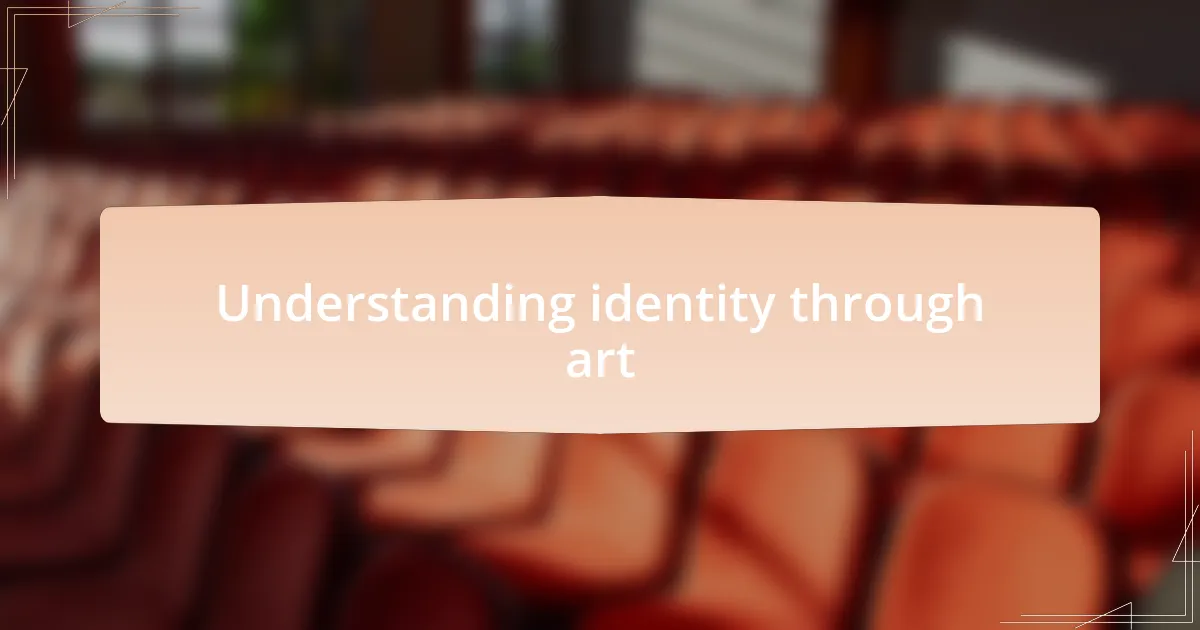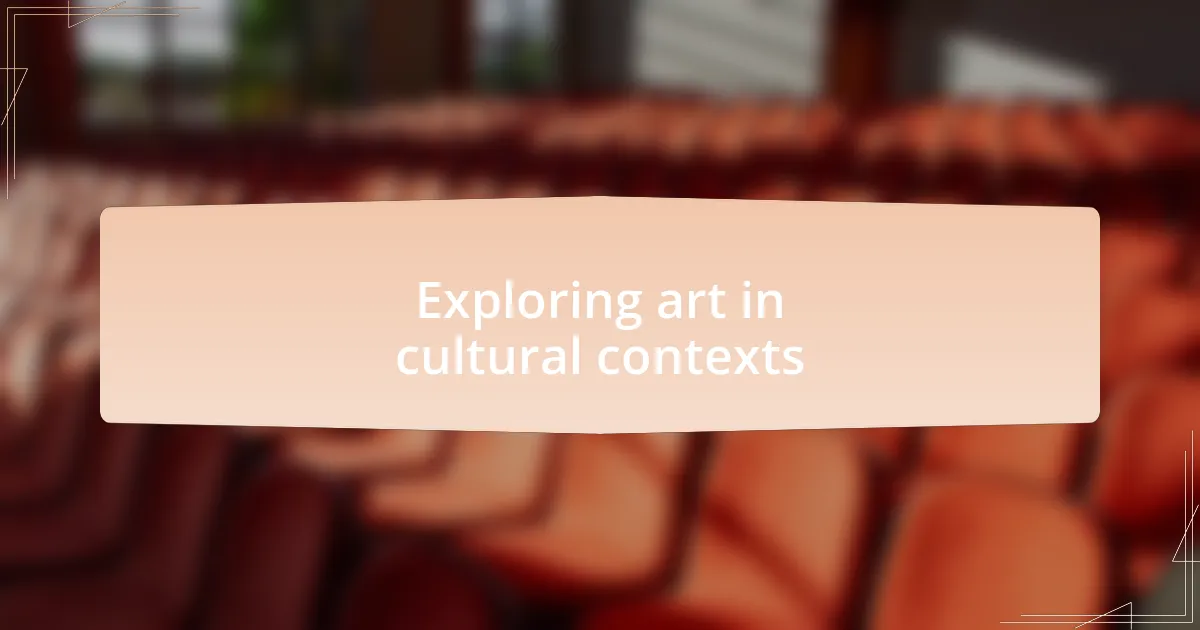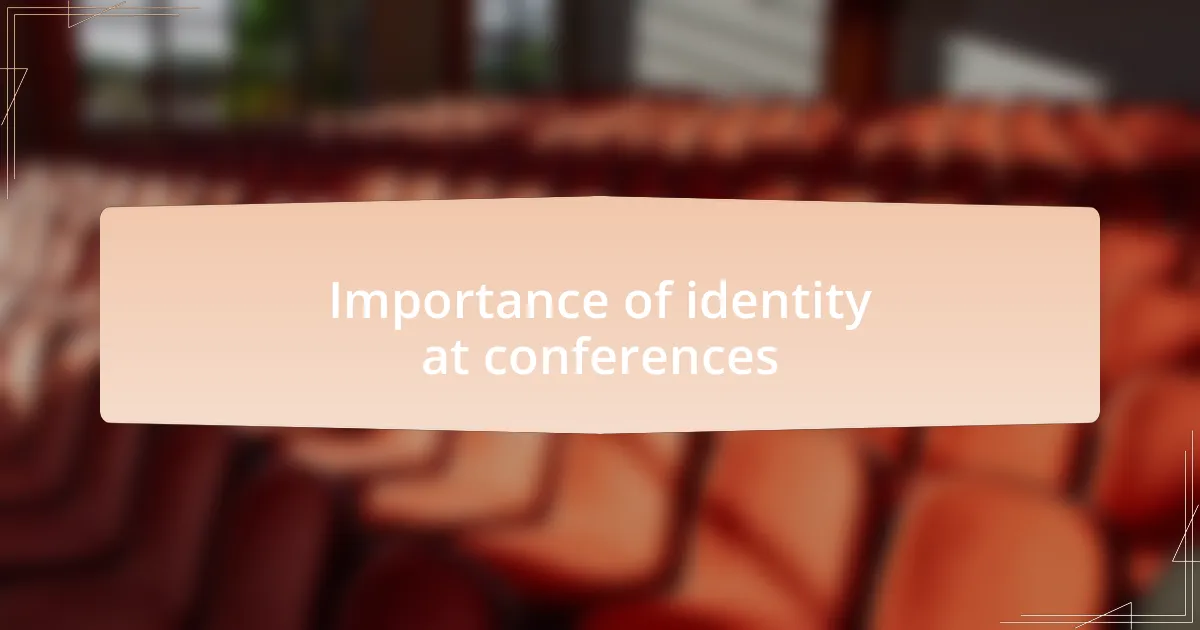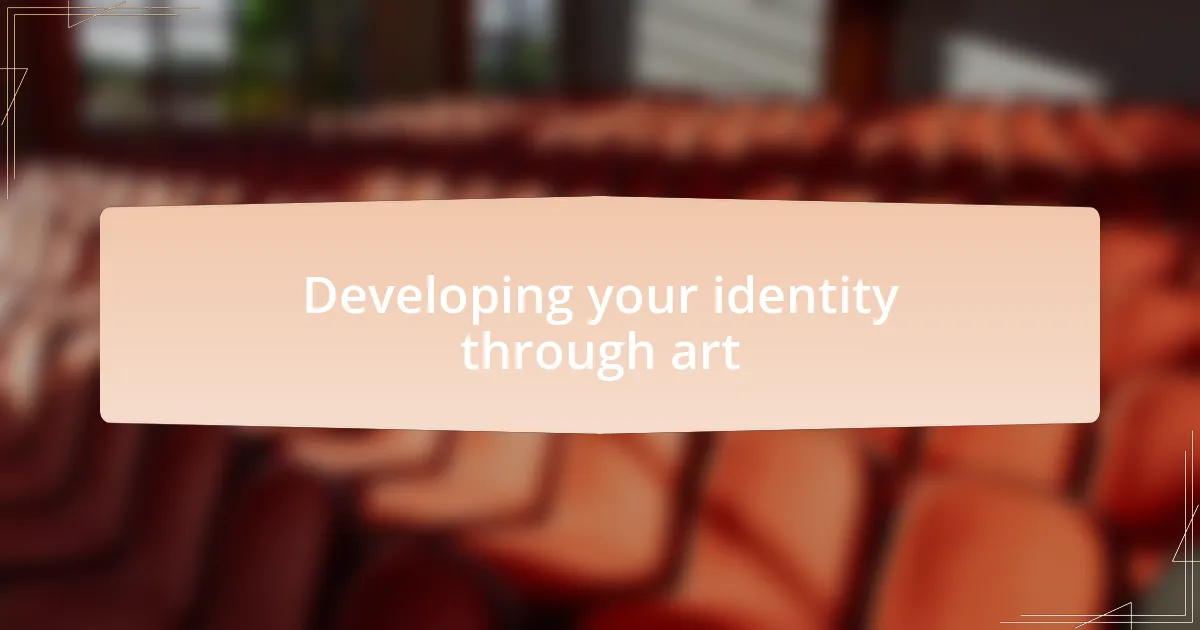Key takeaways:
- Art effectively reflects and shapes personal identity, serving as a medium for expressing complex emotions and cultural narratives.
- Engaging with cultural art fosters deeper connections to heritage and encourages conversations about identity and belonging.
- Conferences that prioritize diverse identities enhance discussions and foster empathy, reinforcing the transformative power of shared stories.
- Art serves as a tool for introspection, allowing individuals to integrate their past with their present and confront personal truths.

Understanding identity through art
Art has an incredible ability to reflect and shape one’s identity. I remember standing in front of a mural that depicted the complexities of my culture, each brushstroke telling a story of resilience. It made me wonder: how often do we overlook the narratives embedded in art that are mirrors of our own journeys?
When I create, I find myself digging deep into my emotions, exploring the intersections of my cultural background and personal experiences. I once painted a piece that represented the duality of my existence, feeling both pride and sorrow in my heritage. In those moments, I realized how art transforms my internal conflicts into something tangible, inviting others to connect with my story.
Through exploration, I discovered that art not only communicates identity but also provokes thought. It raises questions about who we are and how we fit into the larger tapestry of society. Have you ever considered how a single image or a song can encapsulate the essence of a community? I believe that these artistic expressions allow us to not only share our identities but also discover the common threads that bind us together.

Exploring art in cultural contexts
Art serves as a bridge between individuals and their cultural contexts, bringing forth a deeper understanding of identity. I recall visiting an art exhibition featuring pieces from various Palestinian artists, each artwork resonating with stories of struggle and hope. In those moments, I felt a profound connection—not only to the artists but also to the broader narrative of my people.
While creating my own art, I often reflect on the cultural symbols that surround me. For instance, when crafting a piece inspired by traditional Palestinian embroidery, I realized how each stitch carries the weight of history. It made me think: what stories do the colors and patterns tell? These cultural nuances not only enrich the artwork but also invite viewers to engage with our shared heritage on a personal level.
Exploring art in cultural contexts opens dialogues that transcend boundaries. I’ve seen how a single canvas can spark conversations about identity and belonging, prompting me to ask: how do we define ourselves in relation to our communities? Through my experiences, I’ve learned that art is not merely a visual expression; it becomes a vessel for collective consciousness, encapsulating the essence of who we are.

Importance of identity at conferences
Conferences provide a unique space for individuals to express and explore their identities. I remember the first time I attended a conference focused on Palestinian issues; the conversations swirling around me were filled with passion and personal stories. It struck me how identity shapes our perspectives, and I felt invigorated by the shared experiences that bonded us together.
The presence of diverse identities at conferences enriches the discussions and insights shared. I recall a panel where speakers from various backgrounds shared their paths towards understanding their cultural identity. It was a vivid reminder that each person’s story adds depth to our collective narrative. This blend of perspectives not only expands our understanding but also encourages empathy and connection.
When we prioritize identity in these gatherings, we forge an environment that fosters authenticity and vulnerability. I often find myself engaged in side conversations that reveal hidden layers of resilience and creativity. It makes me ponder: how can our identities continue to shape the pathways we create in our communities? The recognition of each individual’s story is not just important; it’s transformative, enriching both personal and collective experiences at conferences.

Personal reflections on art experiences
I often find that my art experiences serve as a mirror reflecting my evolving identity. One particularly memorable moment was when I stood before a canvas that seemed to pulse with the colors of my heritage. With each brushstroke, I felt a surge of connection, as if I was reclaiming pieces of my past and weaving them into my present. Have you ever felt the weight of your history come alive in a tangible form?
There have been times when my creative process felt like a journey into unfamiliar territory. I remember creating a series of portraits that depicted diverse Palestinian figures, immersing myself in their stories. As I painted, layers of frustration, joy, and hope emerged, reminding me of the resilience of our community. It’s amazing how art can articulate what words sometimes cannot, isn’t it?
Engaging with art also forces me to confront uncomfortable truths about myself. At one exhibit, I shared my work alongside others who expressed pain and healing through their art. Their bravery kindled a spark in me, leading to a deeper exploration of my own struggles and achievements. How often do we allow ourselves to be vulnerable in our artistic expressions? This vulnerability, I believe, is essential in nurturing a sense of belonging within our identities.

Developing your identity through art
Developing your identity through art can be an illuminating journey. I vividly recall a night spent sketching under the stars, enveloped in the sounds of my neighborhood. The images that flowed from my pencil revealed not just physical surroundings but deep emotions tied to home—the laughter, the struggles, and the dreams of my community. Have you ever noticed how a simple line can evoke such a profound sense of belonging?
There was a particularly striking moment when I incorporated traditional Palestinian motifs into my work. As I layered these cultural symbols, I realized how enriching it was to intertwine my past with my present. Each motif became a narrative thread, connecting me to my roots while allowing me to express who I am today. Isn’t it fascinating how art can serve as a bridge between generations?
Art also encourages introspection. I remember a time when I stumbled upon an old sketchbook filled with my childhood drawings. The innocence of those early works made me reflect on how much I’ve changed and yet how some core aspects still resonate with me. In this way, I think art acts like an anchor, grounding our identities while pushing us toward growth. What does your artistic journey reveal about you?